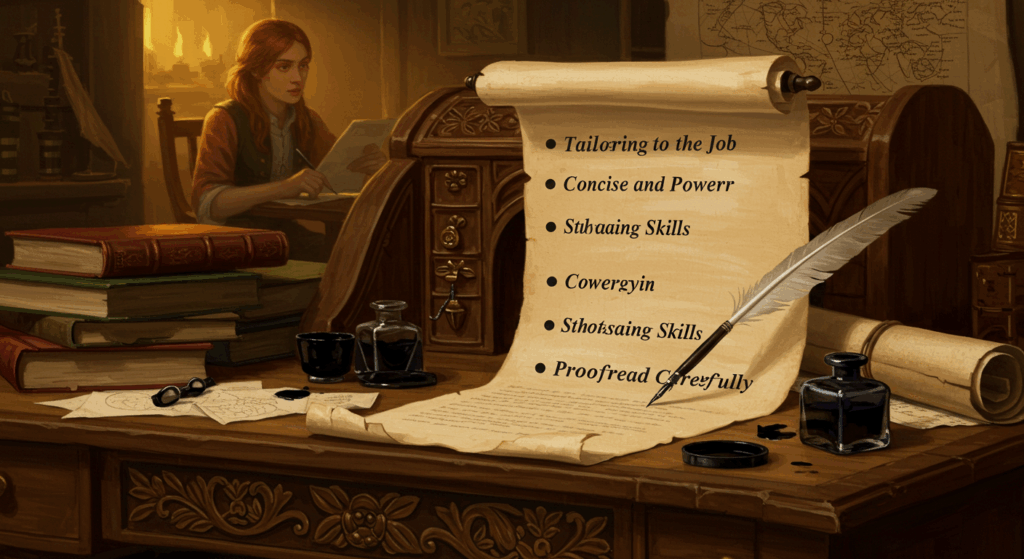So you’re staring at yet another job application portal and it’s like, “Upload resume,” “Link your portfolio,” and then… “Attach cover letter.” Cue internal sigh. Do you actually need one? What’s the meaning of a cover letter, really? And why do some people swear it’s a game-changer while others treat it like the parsley sprig on top of a steak—pretty, but kinda extra?
Take a breath. Grab your coffee (or, let’s be honest, a melted iced latte that’s 70% ice water at this point). I’m going to walk you through what a cover letter actually is, the purpose behind it, how to write it without sounding like a robot, and yes, real mini examples you can steal. We’ll keep it wildly practical, a little funny, and totally doable—even if your brain is currently in “Netflix-and-zone-out” mode.
What Even Is a Cover Letter? (Meaning, but make it human)
Short version: A cover letter is a brief, tailored note that introduces you to the hiring team and explains why you’re the right person for this specific role—like your resume’s outgoing best friend who tells a story, not just bullet points.
Less short, more useful meaning:
Your resume lists facts. Your cover letter adds context. It connects the dots between your experiences and the job’s needs, shows you understand the company, and gives a hint of your personality. Think of it like a DM that isn’t creepy: polite, confident, and specific.
Here’s the non-boring meaning of a cover letter in one sentence:
It’s your chance to present a narrative—to say, “Here’s who I am, here’s what I’ve done, here’s why it matters to you, and here’s what I’ll do next.”
The Purpose of a Cover Letter (No, it’s not just “because HR said so”)
Let’s get the purpose straight, because when you get this, writing becomes way easier:
- Translate your resume into results.
Your bullet points say “Led project X.” Your cover letter says “Led project X, which cut onboarding time by 37%, saving the team ~120 hours each quarter.” Purpose: connect impact to the employer’s goals. - Prove you can communicate.
Most jobs require clear writing. A crisp cover letter = Exhibit A. Purpose: showcase communication skills, tone, and judgment. - Show you did your homework.
Mentioning the company’s product, mission, or current challenges proves you’re applying to them, not 200 random postings at 2am. Purpose: signal intentionality and cultural fit. - Bridge career leaps.
Switching industries? Returning from a break? Your cover letter explains the “why now.” Purpose: reduce any doubt. - Call your shot.
End with a confident ask: a conversation, a demo, a portfolio walkthrough. Purpose: make it easy for them to take the next step.
If you remember one thing: the purpose of a cover letter is to make the human (or yes, sometimes software) reading your app think, “This person gets us—and could help.”
Cover Letter vs. Resume (And Why Both Matter)
- Resume: snapshots, achievements, dates, skills.
- Cover Letter: story, motivation, relevance, voice.
They work together. Your resume is the playlist; your cover letter is the vibe that ties the songs together. Without the cover letter, the hiring manager has facts but no through-line. Without the resume, your confident “I’m perfect!” is cute but unproven. You need both.
When You Actually Need a Cover Letter (and when you can chill)
- Definitely write one if the job asks for it, you have a personal referral, or the role is competitive (hi, anything with “creative,” “strategy,” or “marketing” in it).
- Helpful to write if your resume is nontraditional, you’re early career, or you’re pivoting.
- Maybe skip (or keep super short) if the portal has tiny text boxes for “additional info” and no upload field, or if the recruiter explicitly says “no cover letter needed.”
Ngl, sometimes the “cover letter” becomes a short, punchy intro email.
Anatomy of a Great Cover Letter (Meaning, Purpose, Examples baked in)
1) Header & Greeting
Keep it clean. Use your contact info at the top. If you know the name of the hiring manager, use it (“Hi Taylor,” or “Dear Ms. Nguyen,”). If not: “Hello [Team Name] Team,” works. Avoid “To whom it may concern” unless we’re mailing a parchment scroll by raven.
2) Opening Line (Your hook)
You have 1–2 sentences to keep them reading. Options:
- Spark a connection: “As a daily user of [App], I’m excited by how your new feature uses conmunity feedback to shape the roadmap.”
- Lead with a win: “In my last role, I increased organic traffic 88% in six months—now I’m ready to do that for [Company].”
- Show mission alignment: “I believe climate tech is the most urgent problem of our lifetime, which is why [Company]’s work grabbed me.”
3) Core Paragraph(s): Prove it
Pick 2–3 strong, role-relevant wins. For each: situation → what you did → measurable result → how that maps to this job. Keep it tight. Numbers help. If you don’t have perfect metrics, use relative outcomes (faster, higher, reduced, improved).
4) Why Them (the Purpose paragraph)
Show you know the product, users, or strategy. Mention a recent launch, customer pain point, or market shift. Two sentences is enough to prove the purpose of your application is intentional, not random.
5) Close with Momentum
End with confidence and a CTA: “I’d love to share how we can reach 20% conversion in Q4,” or “Happy to walk through a 5-slide teardown of your sign-up flow.” Then: “Thanks for your time—looking forward to connecting.”
How Long Should It Be?
Sweet spot: one page or around 250–400 words. Scannable. Think “thoughtful text,” not “novella.” If you’re including examples or a quick portfolio note, you can stretch to ~450 words, but keep it tight. Recruiters skim.
Voice & Tone Tips (aka how to sound like a person)
- Be warm, not mushy. Friendly is great; oversharing is… not.
- Use plain words. “I improved onboarding” beats “I spearheaded cross-functional enablement synergies.” (I promise.)
- Match the brand. Fintech? Crisp and precise. DTC brand with sparkly emojis? You can be a little playful.
- Confidence > apology. Replace “Although I don’t have X…” with “Here’s how my Y directly supports X.”
Common Mistakes to Avoid
- Copy-pasting the same letter to every company. (You can feel the generic from space.)
- Restating your entire resume. Add context, not duplication.
- Passive language. “Responsibilities included…” (zzZ). Try “I built,” “I led,” “I shipped.”
- Vague fluff. “I’m a hard worker and team player.” Show proof instead.
- Typos. Run it through spellcheck. Then read it out loud. (Yes, really.)
- No ask. End with a next step.
- No formatting. Big blocks of text = instant eye fatigue.
The “Meaning, Purpose, Examples” Section (because SEO but make it natural)
Cover Letter Meaning—The Real-World Take
In real life, the meaning of a cover letter is: translate your background into the employer’s language. It’s not a biography. It’s a message tailored to their needs that shows you understand what matters to them and how you’ll deliver it.
The Purpose—What It’s Trying To Do for You
The purpose is to make it easy to say yes to an interview. That’s it. Not to be poetic, not to impress your English teacher, but to move you to the next stage.
Examples—Three Mini Letters You Can Borrow
Below are condensed examples (short on purpose) for different roles. Tweak them. Make them yours. Keep the structure: hook → wins → why them → CTA.
Mini Example #1: Marketing (Growth/Content)
Subject: Growth Marketer → From 0 to 100k visits (and beyond)
Hello [Company] Team,
I’m a growth marketer who took [Previous Co] from 0 to 100k monthly organic visits in eight months by shipping a user-intent content strategy and optimizing conversion paths. That work lifted free-to-paid conversion by 22% and cut CAC 19%.
Why [Company]? Your launch of [Feature] tells me you’re prioritizing trials → activation. I’ve increased activation by rebuilding onboarding messaging and running in-app experiments (tooltips + progressive profiling). I’d love to apply the same playbook to your [ICP] and hit Q4 targets.
If helpful, I can send a quick 5-slide teardown of your top funnel pages with 3 high-impact tests to run next.
Thanks for your time,
[Name]
[Portfolio or LinkedIn]
Why this works: Specific wins, business-level outcomes, one sentence about them, and a proactive CTA.
Mini Example #2: Product/UX
Subject: UX Designer who ships delightful, measurable outcomes
Hi Taylor,
I design onboarding and checkout experiences that reduce friction and increase delight (yes, both). At [Co], I re-mapped the sign-up flow and used microcopy + progressive disclosure to reduce drop-off 28%. I also collaborated with Eng to build an A/B framework so our learnings stuck.
I’m excited about [Company]’s focus on community features. Your recent [release/blog post] showed you’re listening to power users; I’d love to help translate those insights into a smoother onboarding moment and a cleaner IA for new folks.
Open to sharing a quick Figma walkthrough and user jurney map, if useful. Thanks for considering!
Best,
[Name]
[Portfolio link]
Why this works: Human voice + measurable impact + clear alignment to the company’s current direction.
Mini Example #3: Early Career / Career Switch
Subject: From teacher → People Ops associate (skills that transfer)
Hello People Team,
For three years, I managed classrooms of 25–30 students, coordinated schedules with 12 colleagues, and launched a peer-mentoring program that improved attendance 15%. Translation: I can organize chaos, communicate clearly, and keep humans on track with care.
I’m drawn to [Company] because your values—especially [Value]—map to my style of building trust. I’d be excited to support onboarding, scheduling, and culture projects while learning HRIS basics quickly (already working through [Course or Tool]).
If you’re open, I’d love to share a 30-60-90 plan for the role. Thanks so much.
Warmly,
[Name]
[LinkedIn]
Why this works: It reframes non-traditional experience into business value, then makes a confident ask.
Template You Can Copy (then trim to fit)
Pro tip: Paste this into your doc, replace [brackets], and cut anything that doesn’t apply. Keep it ~300 words.
Greeting:
Hello [Hiring Manager Name/Team],
Hook (1–2 sentences):
I’m a [role] who [biggest relevant win/result]. At [Previous Co], I [action you took] which led to [metric/result]. I’d love to bring the same energy to [Company] as your next [Job Title].
Body (2–3 wins, 3–5 sentences total):
- Led [project] that [impact/metric], partnering with [teams/tools].
- Built [thing/process] that saved [time/cost] and improved [metric].
- Shipped [feature/campaign] that drove [result], learned [insight].
Why Them (1–2 sentences):
I’m excited about [Company] because [recent launch/mission/market shift]. I see an opportunity to [specific idea aligned to role].
Close (1–2 sentences):
Happy to share a [brief spec/teardown/portfolio walk-through]. Thanks for your time—I’m excited to connect about how we can hit [team goal] together.
Best,
[Name]
[Links]
Formatting That Actually Helps
- File type: PDF unless told otherwise. Keeps your spacing clean across devices.
- File name:
Firstname-Lastname-Cover-Letter-Company-Role.pdf - Font & spacing: 10.5–12 pt; 1.0–1.15 line spacing; generous margins.
- Length: 3–5 short paragraphs. Add a little breathing room.
- Links: One link to portfolio/LinkedIn is perfect. Two max.
- Style: Bold sparingly (company names, roles), avoid highlight color explosions.
But What If I Don’t Have Numbers?
You probably do—you just haven’t translated them. Try:
- Relative improvements: faster, cheaper, higher, reduced
- Scope: managed 12 clients, trained 40 volunteers, coordinated 5 events
- Consistency: met weekly SLAs, hit 100% on time deliverables for 6 months
- Quality: reduced defects, improved CSAT/feedback, fewer escalations
When you can’t find a stat, explain the impact story: problem → action → what changed.
“Do I Need to Address Salary, Relocation, or Availability?”
- Salary: Wait for later stages unless asked. If requested in the posting, give a range (“My expected range is X–Y, flexible based on scope and benefits.”)
- Relocation/remote: If relevant, mention your plan (“Relocating to Austin in December,” or “Located in Jakarta; aligned to GMT+7 with flexible overlap.”)
- Availability: If the timeline matters (“I can start after October 15”), say it.
How to Personalize Without Spending Forever
Here’s a 10-minute personalization loop that’s realistic even when your brain is fried:
- Skim the job description. Copy 3 key responsibilities or skills.
- Find the company signal. Check their site/LinkedIn for a recent product update or initiative.
- Map 2–3 wins. Choose stories from your resume that directly prove you can do those responsibilities.
- Write your hook with your best relevant win.
- Drop in the “Why them” sentence referencing the update/initiative.
- CTA: offer a quick, relevant asset (mini teardown, short plan, portfolio section).
This turns a generic cover letter into a tailored one—with purpose. And it seriously helps you stand out in a stack of Ctrl-C/Ctrl-V submissions.
Quick FAQs (Because your brain has questions)
Q: Do people still read cover letters?
A: Plenty do—especially hiring managers and founders. And even when they skim, the presence of a thoughtful letter signals effort and can nudge you into the “interview” pile.
Q: How formal should I be?
A: Match the brand. If the company voice is playful, you can be a little casual. But keep it professional-friendly, not group-chat chaotic.
Q: Can I reuse parts?
A: Totally. Keep a “wins bank” of 6–8 bullets you rotate in. Just always personalize the opening and “why them” bit.
Q: Should I mention I got laid off?
A: You can, briefly (“Impacted by org-wide layoffs”), but you don’t have to. Focus on what you bring next.
Q: Do I need to attach or paste it?
A: Follow the instructions. If unclear, PDF attachment + a short, friendly email intro is a solid default.
Real-World Walkthrough (From Job Post to Draft in ~15 Minutes)
Let’s pretend the job is “Operations Coordinator at a logistics startup.”
- The post emphasizes: scheduling, vendor coordination, basic analytics, and problem-solving.
- The company recently announced same-day delivery expansion.
Draft:
Hello Ops Team,
At [Previous Co], I coordinated weekly schedules across 4 regions, cut delivery delays 18% by tightening vendor SLAs, and built a simple dashboard to flag route risks daily. I love turning messy logistics into predictable systems (and yes, color-coded spreadsheets are my personality).
I’m excited about [Company]’s same-day expansion. I’ve rolled out dispatch checklists and escalation playbooks that reduced last-mile issues by ~22%. I’d like to bring that approach to your new hubs and help you stabilize on-time delivery as you scale.
Happy to share a one-page sample dashboard and a draft escalation matrix if helpful. Thanks for your time!
Best,
[Name]
Why it works: It mirrors the job’s needs, shows wins with light metrics, references the company’s current focus, and offers relevant examples to keep the conversation going.
Advanced Moves (When you want to go from good → “who is this rockstar?”)
- Attach a 1-page spec or teardown (only if it’s tasteful and not overkill). Tie it to the role’s top challenge.
- Name future wins. “In 30 days, here’s what I’d audit. In 60, here’s the experiment. In 90, here’s the KPI I’ll own.”
- Show you understand tradeoffs. “I’d start with an email onboarding win before rebuilding the whole product tour,” etc.
- Use one crisp sentence that screams fit. “I’ve solved this exact churn problem for a PLG SaaS with a similar ICP.”
Mindset Shift: From “Pick Me” to “Here’s the Plan”
Here’s a lil reframe that changes everything:
You’re not begging for approval. You’re proposing a collaboration where you solve their problems. Your cover letter’s meaning lights up when it’s not “I want a job” but “Here’s how I’ll help you hit your goals.”
A Few More Examples (Super Short, Different Flavors)
Data Analyst:
“I turned 2M rows of messy CRM data into clean dasdboards that improved forecasting accuracy by 14%. With your move into self-serve, I’d love to build a product analytics suite to spotlight activation drop-offs and drive a 10% lift in retained users. Can share a Looker sample.”
Customer Success:
“At [Co], I managed 45 SMB accounts with 96% GRR by building proactive QBRs and an onboarding playbook. Since you just launched [Feature], I’d love to create a 3-touch adoption sequence to boost usage within 30 days.”
Software Engineer (Frontend):
“I rebuilt the design system for [App], cutting UI defects 35% and reducing time-to-ship by ~20%. Your focus on performance resonates; happy to share a plan for shaving 300ms off LCP on your marketing site.”
Each is brief, pointed, and anchored in purpose (their goals) with small but mighty examples.
Final Checklist Before You Hit Upload
- Did I tailor the intro to this company?
- Did I pick 2–3 relevant wins (with impact)?
- Did I include one sentence proving I know their product/mission/market?
- Did I avoid resume copy-paste?
- Did I close with a friendly CTA?
- Did I proofread once, then read aloud? (I know. Still do it.)
If yes, you’re good.
Wrap-Up: You’ve Got This (and your future self will thank you)
A cover letter isn’t a school assignment. It’s a bridge—from your experience to their needs. Its meaning is clarity; its purpose is momentum; its examples are the receipts. You don’t need to write the great American novel. You just need to write a clear, kind, confident note that says, “Here’s how I can help.”
Now go draft yours, trim it to 300-ish words, and send it before your brain starts bargaining for “one more episode.” You’re closer than you think.
Ready to make moves? Open a doc, grab the template above, and write the first sentence right now. Future-you (and your next paycheck) will be very, very proud.









